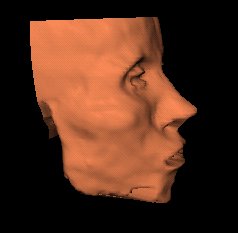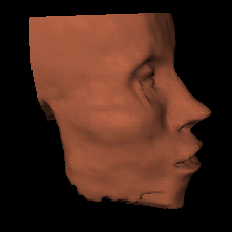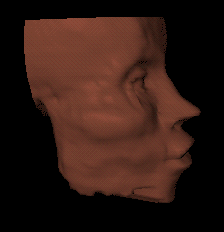


Figure 14 (a-c): Interpolating between the 'White' and 'Black' tissue depths. Click on the image to view 'morphing' VRML file [1.38MB] or view using a slideshow.
It is not possible to divide humanity into biological taxa or 'races' on scientific grounds. Nearly all human genes are shared by all human populations and, indeed, with chimpanzees and gorillas. The range of genetic variation within any ethnic group substantially exceeds the net difference between any two groups. There are no genetic variants possessed entirely and exclusively by any single ethnic group. Races, in the biological sense, do not exist.
Nevertheless there are a small number of biometric characters which are sometimes significantly more frequent in one ethnic group than in another. These differences can be explained by models based on biogeographical history. They are largely trivial, but in a forensic context they can be used to estimate whether the individual would have been likely to have been identified with one or other ethnic group whether they would have been identified as 'White' or 'Black', for example. It seems obvious that this can be enormously important in establishing the identity of an individual. Estimation of ethnic affiliation is highly inaccurate, however, owing to the substantial overlap in variation between ethnic groups, even those historically separated by considerable geographical distance. Features significantly more frequent in 'Caucasoids' will inevitably be present in 'Native Americans', for example providing an obvious, simple and non-controversial explanation for the alleged features of Kennewick Man.
In order to examine how ethnicity-related variation in facial appearance might be simulated in computerised 3-D models, we made casts of an archaeological skull which contained features more frequent in the 'White' population along with features more frequent in the 'Black' population. This individual could conceivably have identified himself as 'White', 'Black', 'of mixed ancestry' or one of a number of other potential ethnic affiliations. We produced standard reconstructions based on the published tissue depths collected from samples of 'Black' and 'White' populations. Scans of these reconstructions were used to construct a VRML model which interpolates between the 'White' and 'Black' reconstructions made from the same skull. A colour interpolator node was also included so that the skin colour hue changed in correspondence with the tissue depth data being applied (Figure 14).



Figure 14 (a-c): Interpolating between the 'White' and 'Black' tissue depths. Click
on the image to view 'morphing' VRML file [1.38MB] or view using a slideshow.
It is important to remember that light skin colour need not accompany 'White' facial features in an individual of mixed African and European ancestry, and that these features may also be inherited in discrete non-additive ways. Nevertheless, our model demonstrates that computer simulations can be used to offer a range of variation from which certain outcomes of reconstructions can be selected in such cases.
© Internet Archaeology
URL: http://intarch.ac.uk/journal/issue8/evison/ethnic.html
Last updated: Mon Jun 26 2000